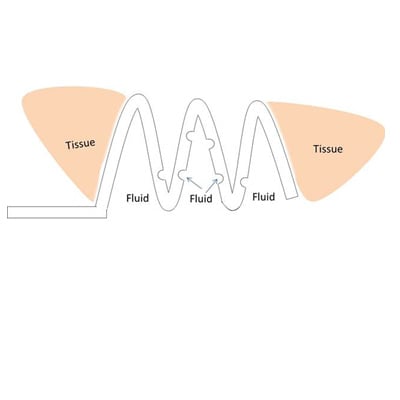
15MA034 Med Device: Improved Pigtail Drainage Catheter for Percutaneous Fluid Aspiration
This new catheter design with a three-dimensional pigtail loop will eliminate many of the problems that traditional drainage catheters face during regular use. Intracavitary structures (such as the pleura/lungs in the chest and the omentum and bowel loops in the abdomen) are often stuck to the side holes due to the suction of the catheter and obstruct the flow of drainage fluid. The 3D Drainage Catheter Needle would solve this issue by physically pushing away these intracavitary structures to create a designated cavity for fluid aspiration, not provided with two-dimensional drainage catheters. Also the positioning of the side holes on the inside of the loops would ensure that the intracavitary structures would not be sucked towards the catheter and obstruct the flow of drainage fluid.
COMMERCIAL OPPORTUNITY
- Fluid evacuation is an important part of diagnosis, treatment and maintenance of many disease presentations of both the pleural (lung) and peritoneal (abdomen) cavities including cancer and liver cirrhosis. About 400,000 individuals in the U.S. suffer from liver cirrhosis, and 60% of these will develop ascites (accumulation of fluid in the peritoneal cavity), and about 10% of patients develop refractory ascites per year. Each of these cases will be treated by using a draining catheter, and a fraction will receive recurrent treatment. Additionally, there are approximately 1.5 million cases of pleural effusions diagnosed in the U.S. per year.
- Two-dimensional drainage catheters are the current standard for pleural and peritoneal aspirations, with most physicians opting to use the Yueh needle catheter (Cook Medical). The Disposable Catheter Needle 5F Yueh for Centesis is priced at $58 giving a conservative yearly potential market size of $87M (using 1.5 million catheters per year).
This new type of drainage catheter is designed to achieve faster and more complete evacuation of various fluid collections from the body, including ascites, pleural effusion, cysts, and abscesses amongst others. The 3D Pigtail Drainage Catheter Needle consists of a hollow stylet needle within a plastic catheter. Following the removal of the stylet needle, the distal end of the plastic catheter conforms to a “pigtail” loop with 2.5 turns. The “pigtail” loop has 6 sideholes on the distal 1.5 turns (side holes begin at the conclusion of the first full loop and located at every ¼ (90 degree) turn on the inner side of the loops). The catheter also has an end hole.
TECHNOLOGY
This new type of drainage catheter is designed to achieve faster and more complete evacuation of various fluid collections from the body, including ascites, pleural effusion, cysts, and abscesses amongst others. The 3D Pigtail Drainage Catheter Needle consists of a hollow stylet needle within a plastic catheter. Following the removal of the stylet needle, the distal end of the plastic catheter conforms to a “pigtail” loop with 2.5 turns. The “pigtail” loop has 6 sideholes on the distal 1.5 turns (side holes begin at the conclusion of the first full loop and located at every ¼ (90 degree) turn on the inner side of the loops). The catheter also has an end hole.
PUBLICATION/PATENT
- PCT international patent application filed 12/13/2016 for Dr. Bela Kis
The Innovation Office
InnovationMarketing@Moffitt.org
(813) 745-6828

